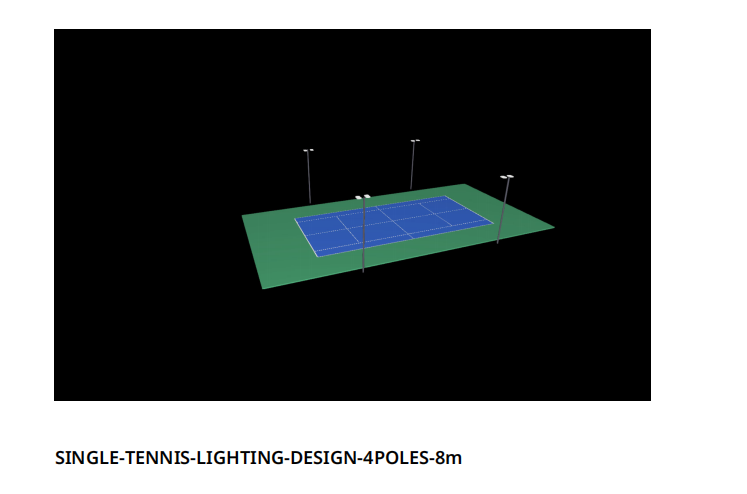Exploring the lighting solutions for tennis courts.
- VKS
- Dec 05, 2024
- Blog
As sports gradually become an important part of people's lives, the lighting in sports venues is also continuously evolving. Sports are influenced by various factors such as space, direction, range, and speed, which imposes more stringent and specific requirements compared to general lighting. In tennis, the small size of the ball and its high speed mean that lighting standards must not only allow players to visually perceive the speed and direction of the ball in order to react quickly, but also ensure high-quality visuals for televised broadcasts, including close-ups of the players, referees, and audience. This places even higher demands on lighting.
1.Safety
(1) Waterproof and Dustproof: The IP protection rating of a lighting fixture refers to its ability to protect against dust and water. The IP rating consists of two digits: the first digit (I) indicates the level of protection against the ingress of dust and foreign objects, with levels ranging from 0 to 6; the second digit (P) indicates the level of protection against water intrusion, with levels ranging from 0 to 8. A higher number indicates a higher level of protection for the fixture.
(2) Lightning protection device: Equipped with an advanced and efficient lightning protection system to reduce damage to the lighting fixtures caused by high-voltage discharges from lightning strikes.
2.Lighting quality
(1) Color temperature: Reduce the difference between the color of artificial lighting and natural daylight, with a requirement of 4000K-6500K. For large venues with television broadcasting needs, a design preference of 5700K is recommended.
(2) Color Rendering Index: To create a pleasant and comfortable environment for athletes and spectators, it is required that Ra ≥ 80. For large venues and events with high-definition television broadcasting needs, to reduce color correction errors of camera filters, Ra ≥ 90 is preferred. Light intensity.
(3) Vertical Illumination: It is important to be able to see the athletes' vertical surfaces clearly, as well as the moving ball or other moving objects. Good uniformity is required to avoid shadows, reduce visual discomfort for both athletes and spectators, and minimize camera corrections. The key to lighting design lies in providing both horizontal and vertical illumination, reducing glare index, and achieving a bright yet non-glaring lighting effe
(4) Horizontal illuminance: The brightness level of the sports venue surface should be comfortable for the eyes.


3. Glare suppression
(1)The external structure of the lighting fixture is designed thoughtfully, featuring an appropriately calculated cutoff angle. This design not only enhances the aesthetic appeal of the fixture but also effectively minimizes light pollution and glare, ensuring a more comfortable and pleasant lighting experience. By incorporating a well-considered cutoff angle, the fixture directs light precisely where it is needed, enhancing visibility while preserving the surrounding ambiance. Such attention to detail in the design process reflects a commitment to both functionality and user comfort, making the lighting fixture a valuable addition to any space.
(2)The optical device features microstructures designed to homogenize light, preventing excessively strong illumination at specific observation points or in certain directions, which could lead to debilitating glare.
This innovative design ensures a more uniform light distribution, enhancing visual comfort and performance. By mitigating intense brightness in focused areas, these microstructures not only improve the overall aesthetic quality of the light but also reduce eye strain for users. This technology is especially beneficial in applications such as display screens, automotive lighting, and architectural illumination, where glare can significantly impact visibility and user experience. Ultimately, the integration of such microstructures represents a significant advancement in optical engineering, promoting safer and more effective lighting solutions across various fields.
(3) Control the projection angle to ensure that the observer's position is ideally situated between the area of slight glare and the area free of glare (greater than 45 degrees).
In order to enhance visual comfort and reduce the impact of glare on the observer, it is essential to carefully manage the projection angle of the light source. By positioning the light so that the observer finds themselves within the narrow band that lies between the slight glare zone and the glare-free zone—specifically at an angle greater than 45 degrees—we can create an optimal viewing environment. This approach not only improves visibility but also contributes to a more pleasant experience, allowing for prolonged focus without the distraction of harsh lighting conditions. Such considerations are particularly important in settings like offices, classrooms, and theaters, where effective lighting can significantly influence productivity and enjoyment.
Lighting is the application of light to the eyes of athletes, referees, and spectators, creating a visual experience. Through vision, people can see a colorful world and enjoy the exciting events on the sports field. VKS Lighting will take you on a journey to explore a different world of sports lighting, allowing you to constantly experience the extraordinary benefits brought by a healthy and comfortable lighting environment!


